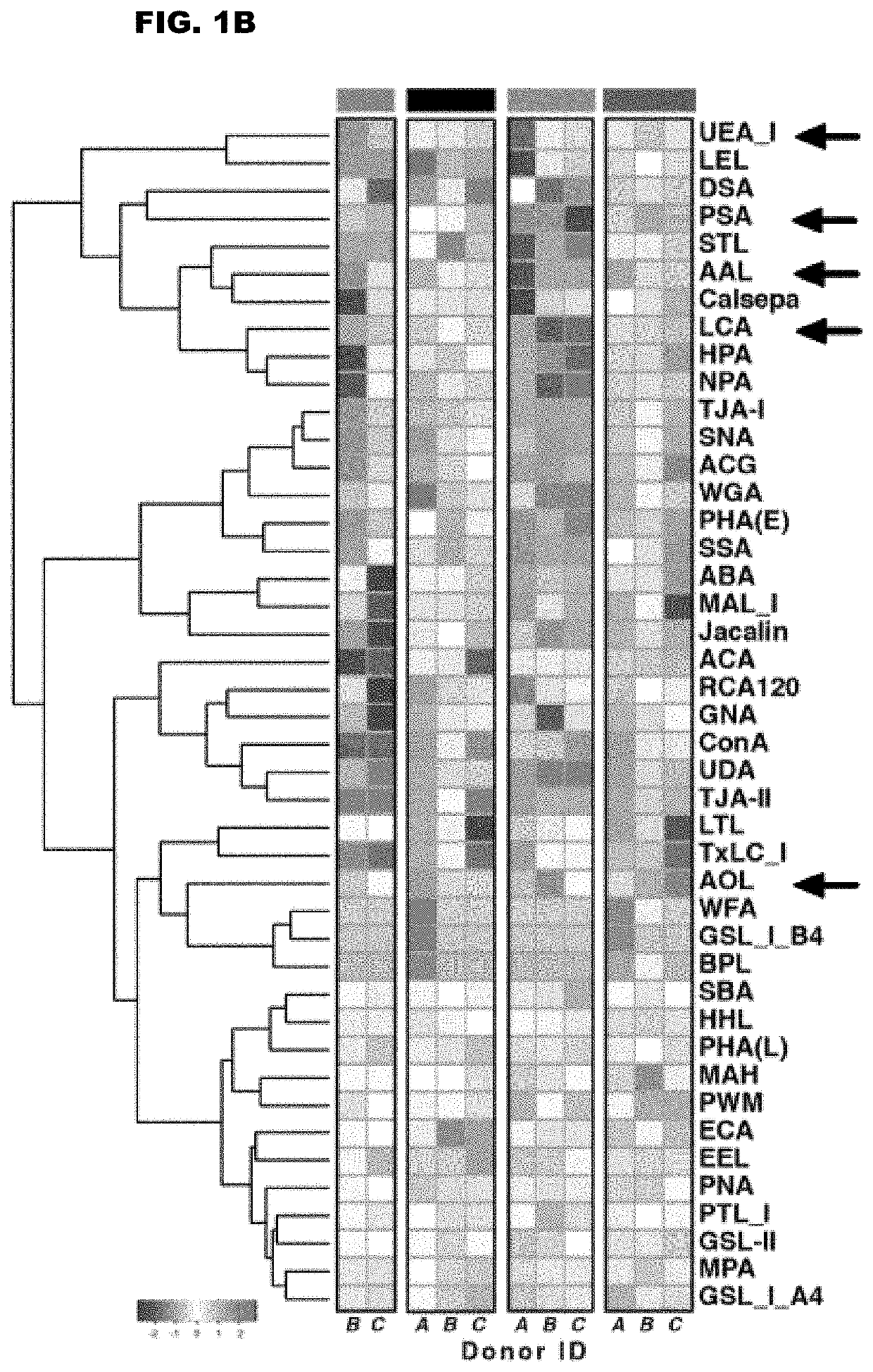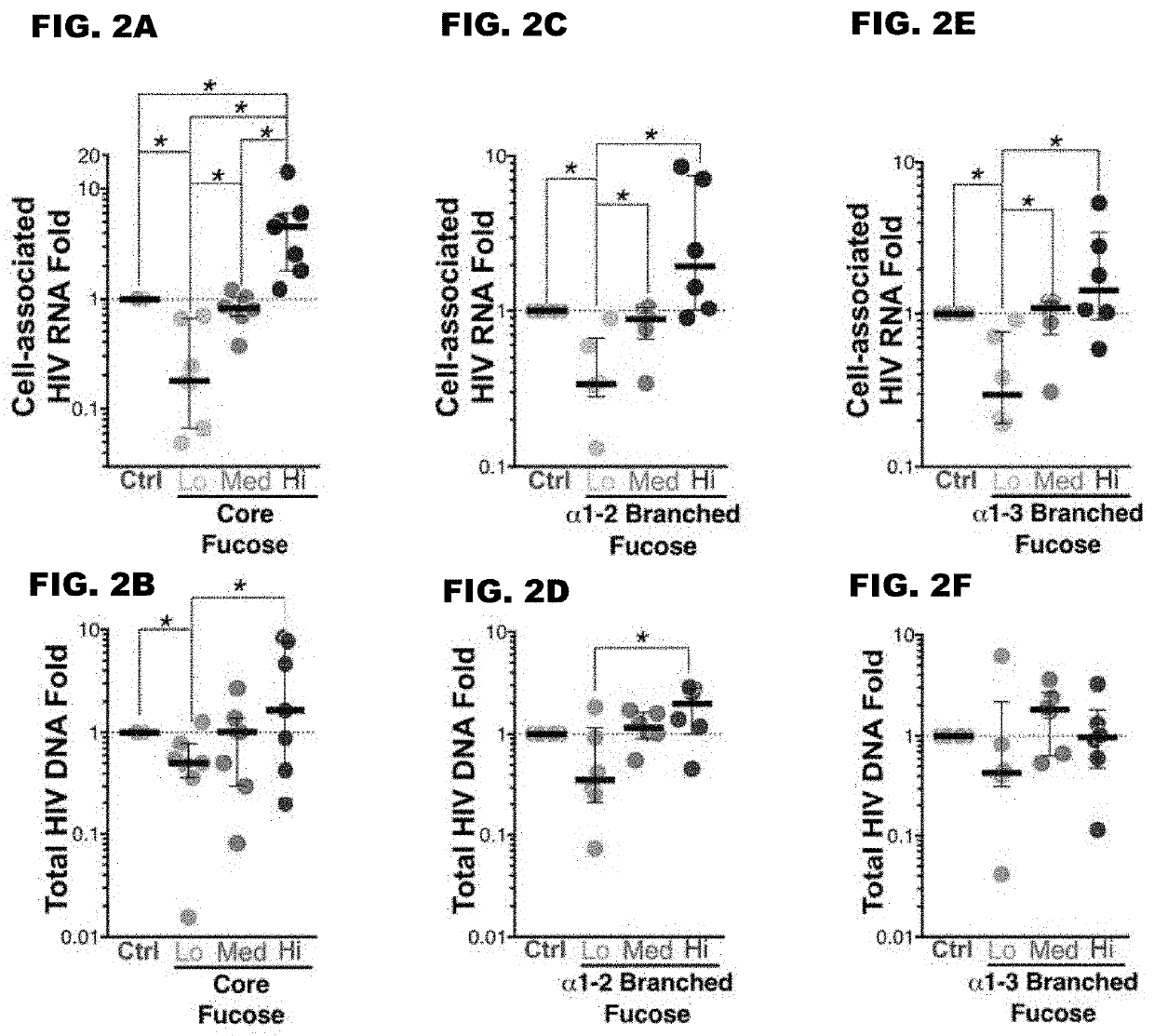Methods and compositions for reducing numbers or eliminating hiv-infected cells
- Summary
- Abstract
- Description
- Claims
- Application Information
AI Technical Summary
Benefits of technology
Problems solved by technology
Method used
Image
Examples
example 1
Signature on the Cd4+ T Cell Surface Associate with Persistent Hiv Transcription In Vitro
[0091]To examine if CD4+ T cell-surface glycomic features associated with HIV persistence, we started by exploiting a dual fluorescent reporter-based HIV (dfHIV2). DfHIV2 enables the differentiation and purification of primary CD4+ T cells into three categories: HIV-infected and transcriptionally inactive, HIV-infected and transcriptionally active, or uninfected (see Battivelli E et al, ref 10, incorporated by reference herein). Primary CD4+ T cells were isolated from HIV-uninfected donors, activated using αCD3 / αCD28, infected with dfHIV2 by spinoculation, and sorted 4 days post-infection into the three categories above. Since HIV infection of primary CD4+ T cells requires activation, the uninfected cells after dfHIV2 infection are activated CD4+ T cells.
[0092]For more accurate control, we included a culture of non-activated CD4+ T cells from the same donors; this culture was treated identically...
example 2
Signature on the Cd4+ T Cell Surface Associate with Persistent Hiv Transcription In Vivo
[0093]We validated our in vitro observations by asking whether different levels of T cell fucosylation corresponded with varying levels of persistent HIV transcription in vivo. We used fluorescently-labeled lectins and sialyl Lewis X (fucosylated antigen) antibodies to sort CD4+ T cells from HIV+ ART+ individuals into populations with low, medium, and high levels of branched or core fucose. Low-fucose sorted CD4+ T cells from HIV+ ART+ individuals exhibited lower levels of cell-associated HIV RNA when compared to cells with high cell-surface fucose (P<0.05 Wilcoxon test; 17.2 fold for core fucose and 8.2 fold for branched fucose) (see FIGS. 2A-2F). Furthermore, levels of core and branched fucosylation on CD4+ T cells significantly correlate with levels of CD4+ T cell-associated HIV RNA in HIV+ ART-suppressed individuals in vivo (see FIG. 3).
example 3
[0094]RNA-Seq was used in the sorted population to characterize the transcriptomes of high-fucose and low-fucose CD4+ T cells from HIV+ ART+ individuals. Ingenuity pathway analysis was used to evaluate the functional significance of differentially expressed genes. Principal component analysis of the transcriptomic profiles showed a clear clustering between the two groups (see, e.g., FIGS. 4A and 4B). Ingenuity pathway analysis showed that the activity of carbohydrate metabolism, glycolysis, T-cell trafficking, mTOR signaling, and ERK / MAPK signaling, being significantly elevated in high-fucose cells when compared to low-fucose cells (FDRx), low levels of L-Selectin, and high levels of GCNT1, a gene essential for core 2 O-glycan branching (see e.g., FIGS. 6A-6C). SLex is a high fucose cell-surface antigen, binds to the cell adhesion molecules (Selectins). This binding allows leukocytes to leave the vascular tree and become recruited into tissues and sites of inflammation. In addition ...
PUM
| Property | Measurement | Unit |
|---|---|---|
| Surface | aaaaa | aaaaa |
Abstract
Description
Claims
Application Information
 Login to View More
Login to View More - R&D
- Intellectual Property
- Life Sciences
- Materials
- Tech Scout
- Unparalleled Data Quality
- Higher Quality Content
- 60% Fewer Hallucinations
Browse by: Latest US Patents, China's latest patents, Technical Efficacy Thesaurus, Application Domain, Technology Topic, Popular Technical Reports.
© 2025 PatSnap. All rights reserved.Legal|Privacy policy|Modern Slavery Act Transparency Statement|Sitemap|About US| Contact US: help@patsnap.com



